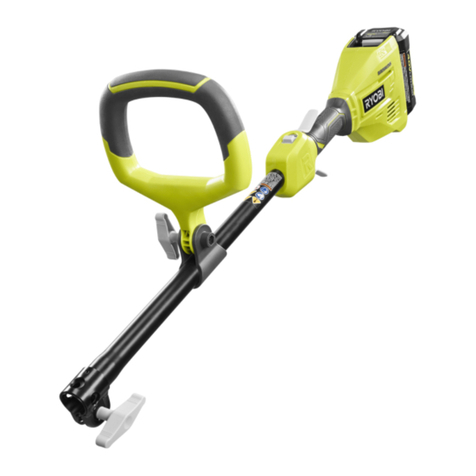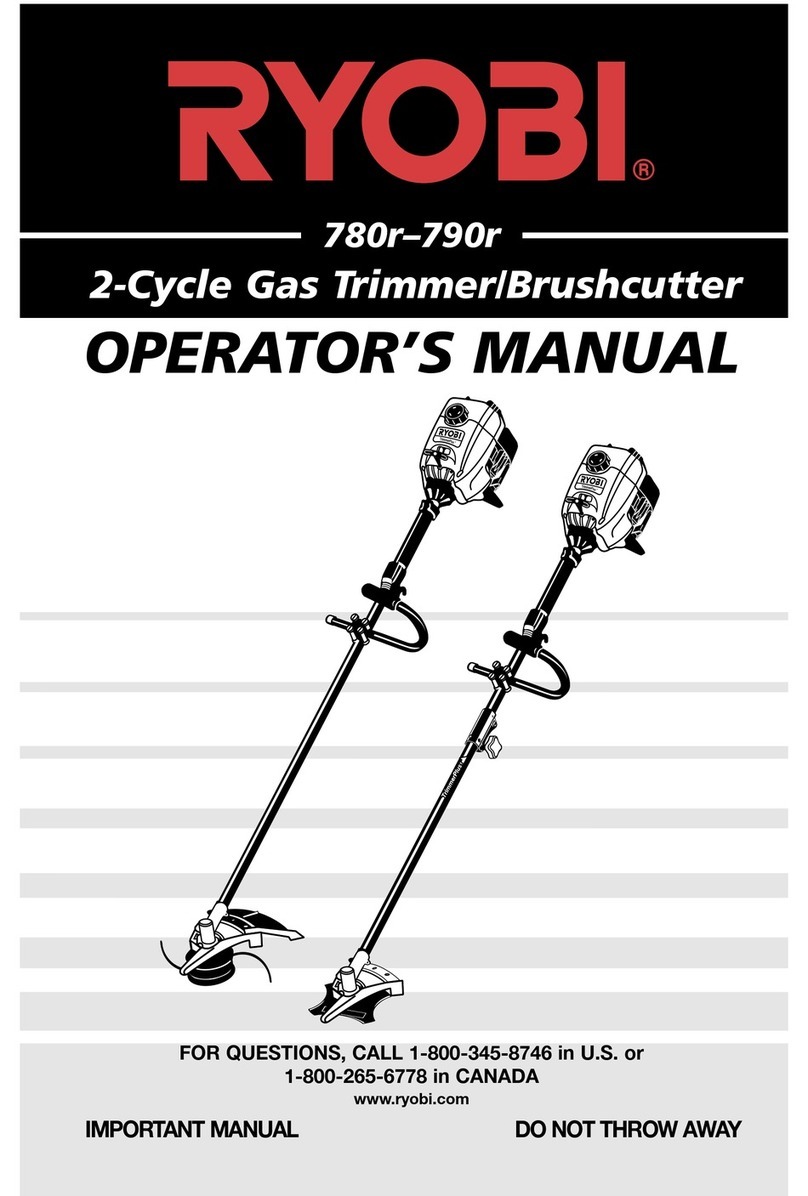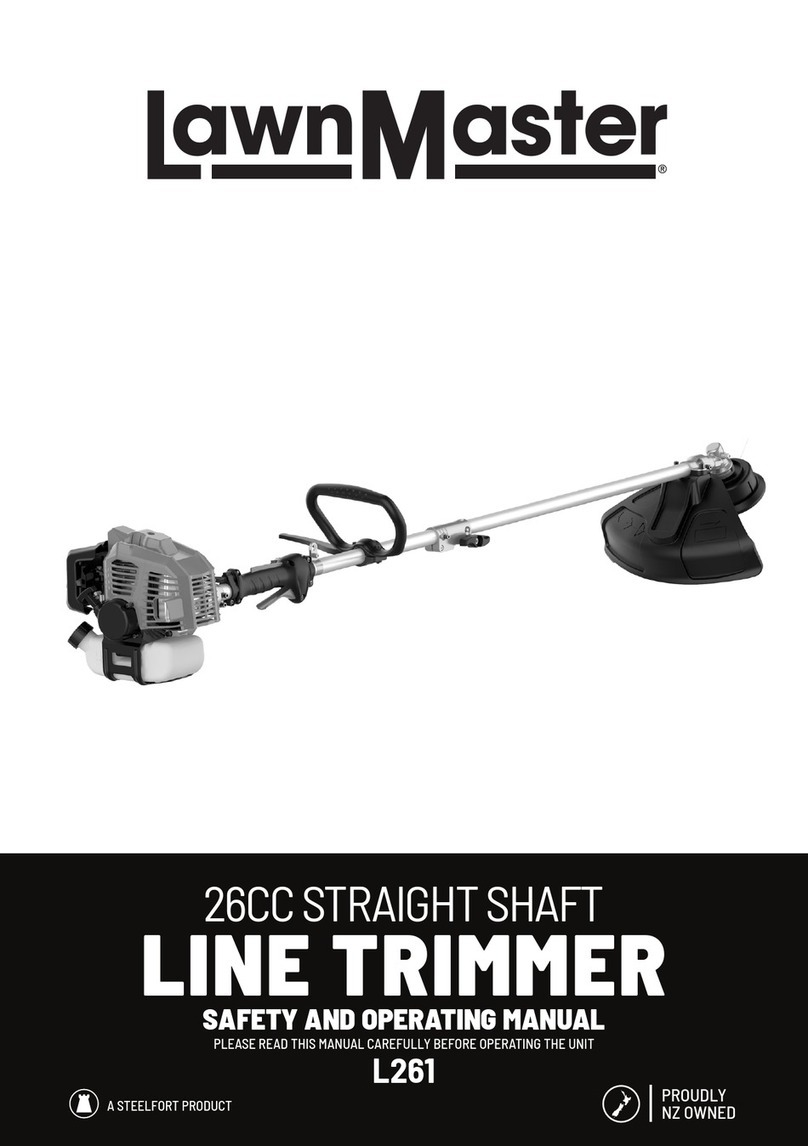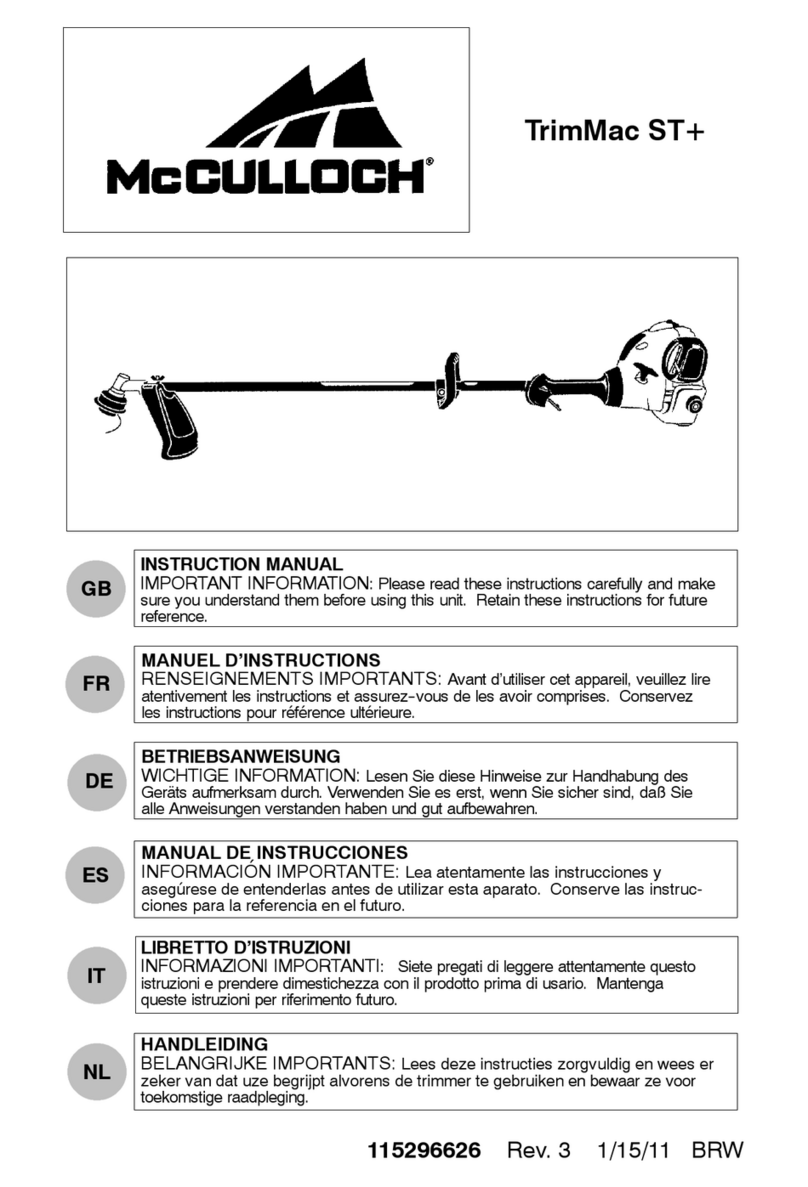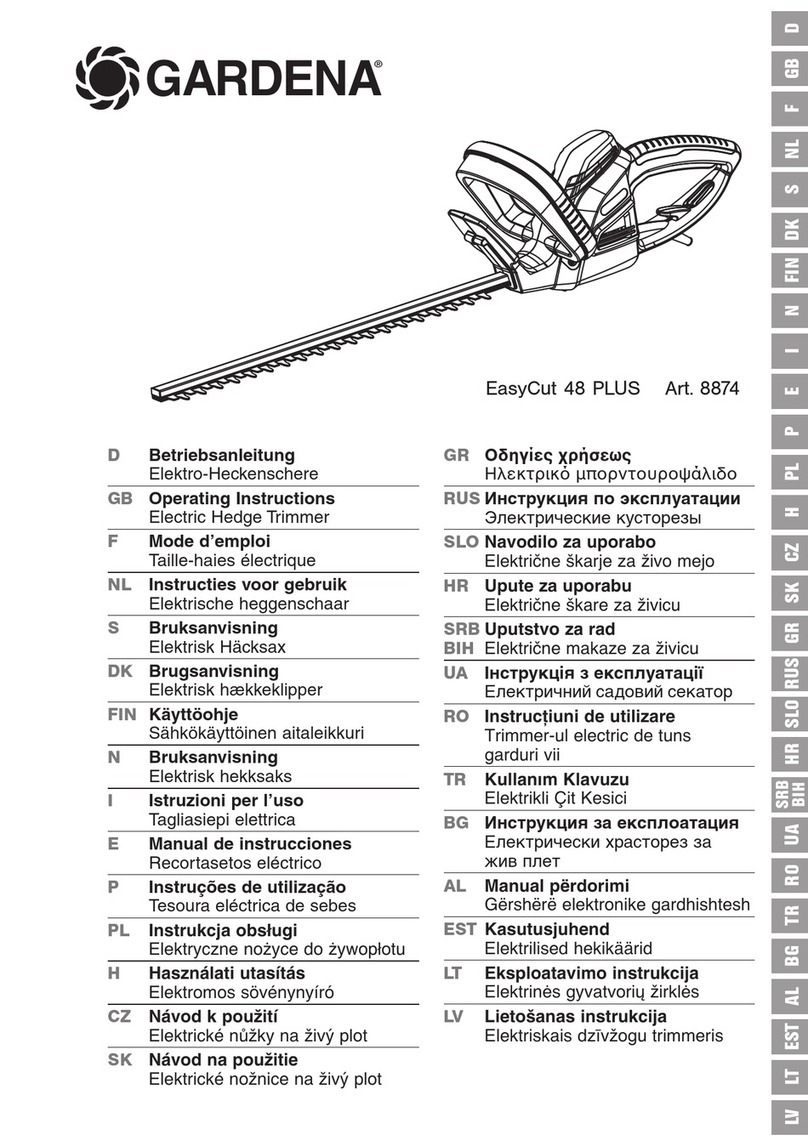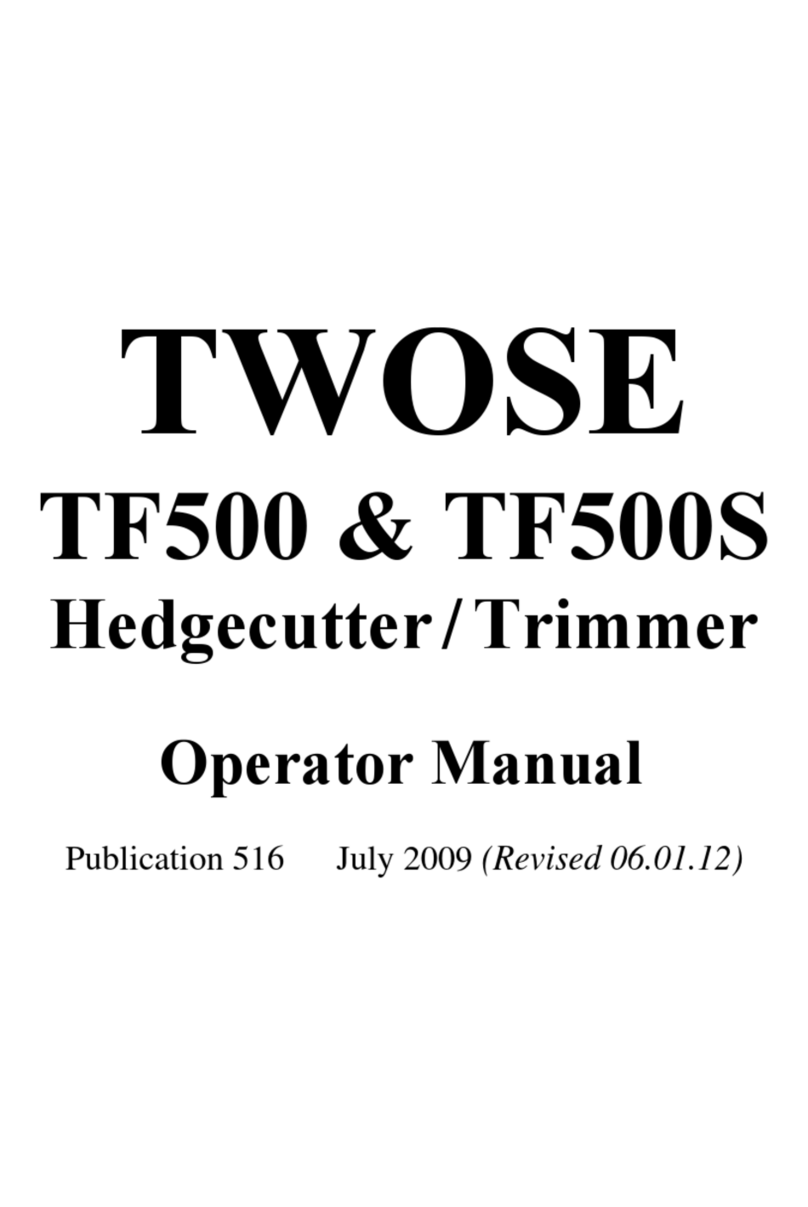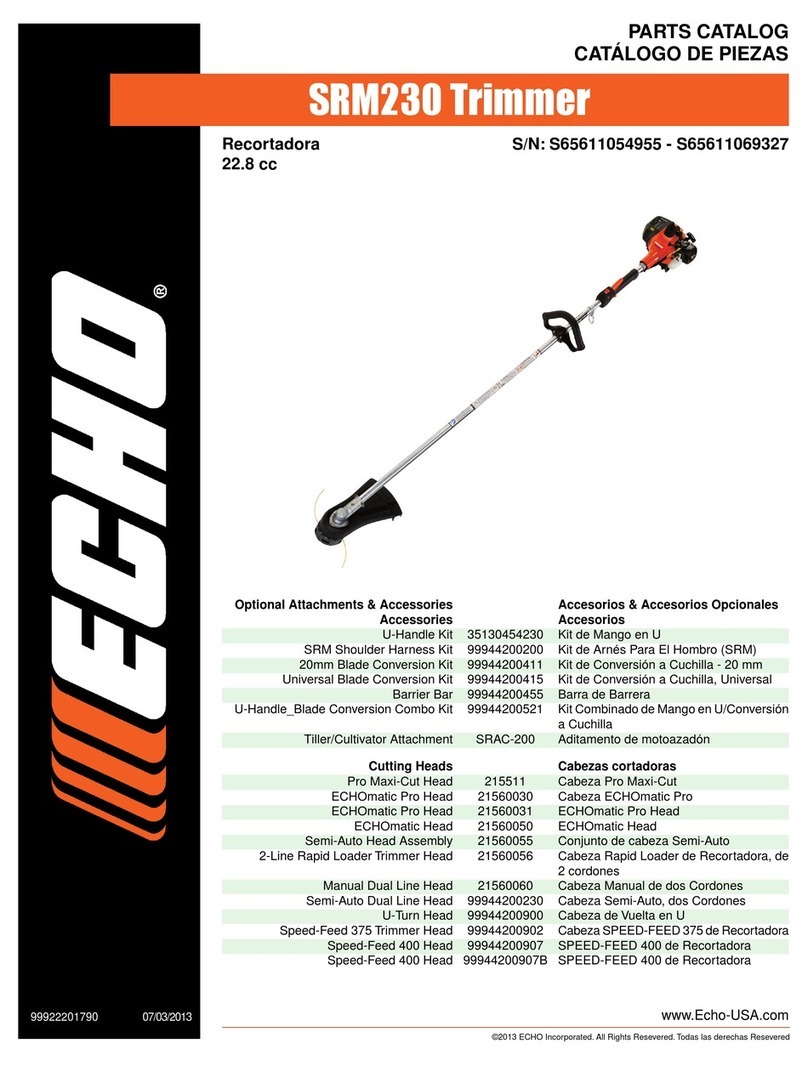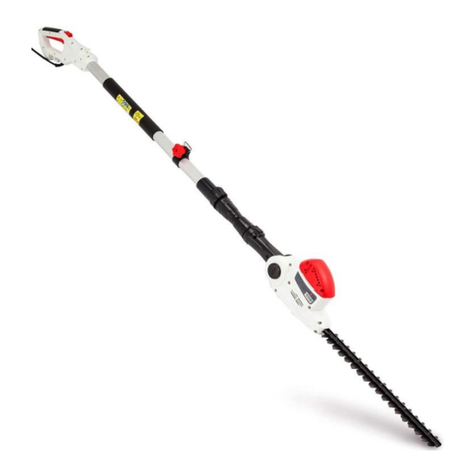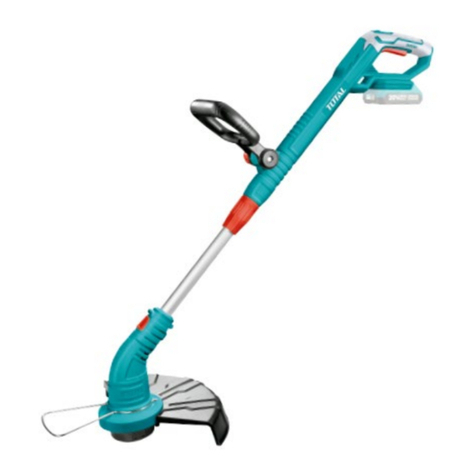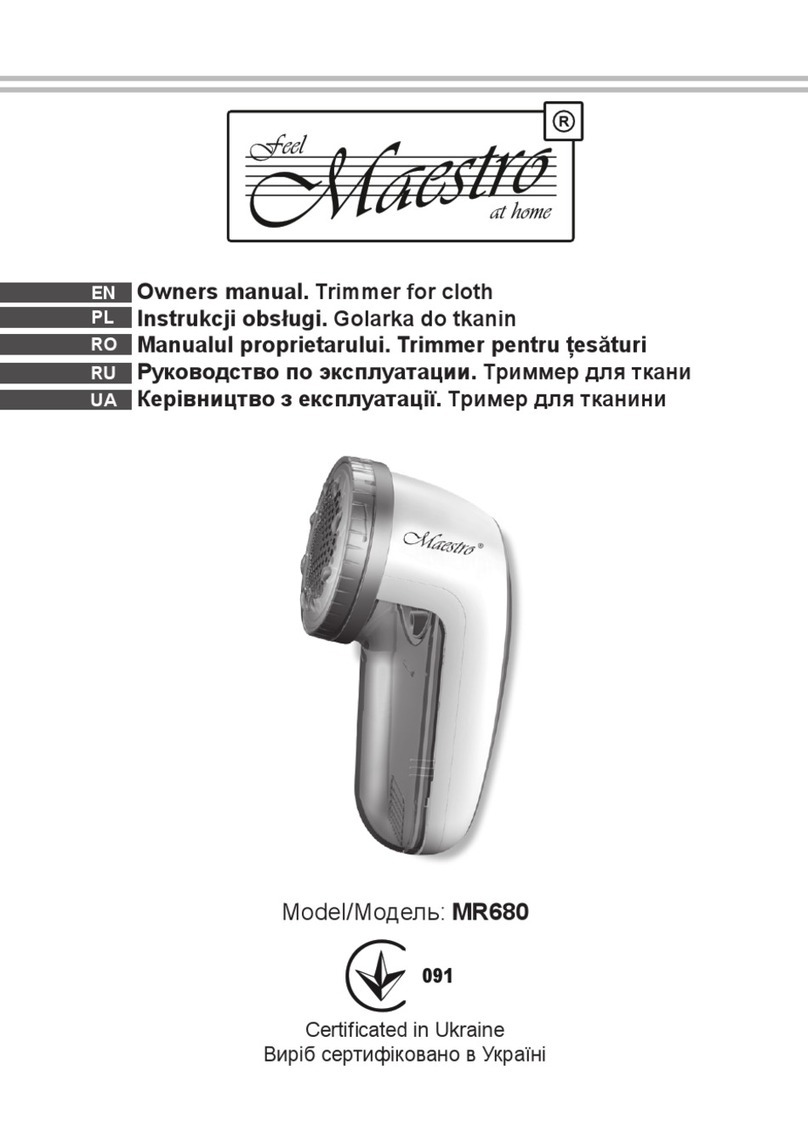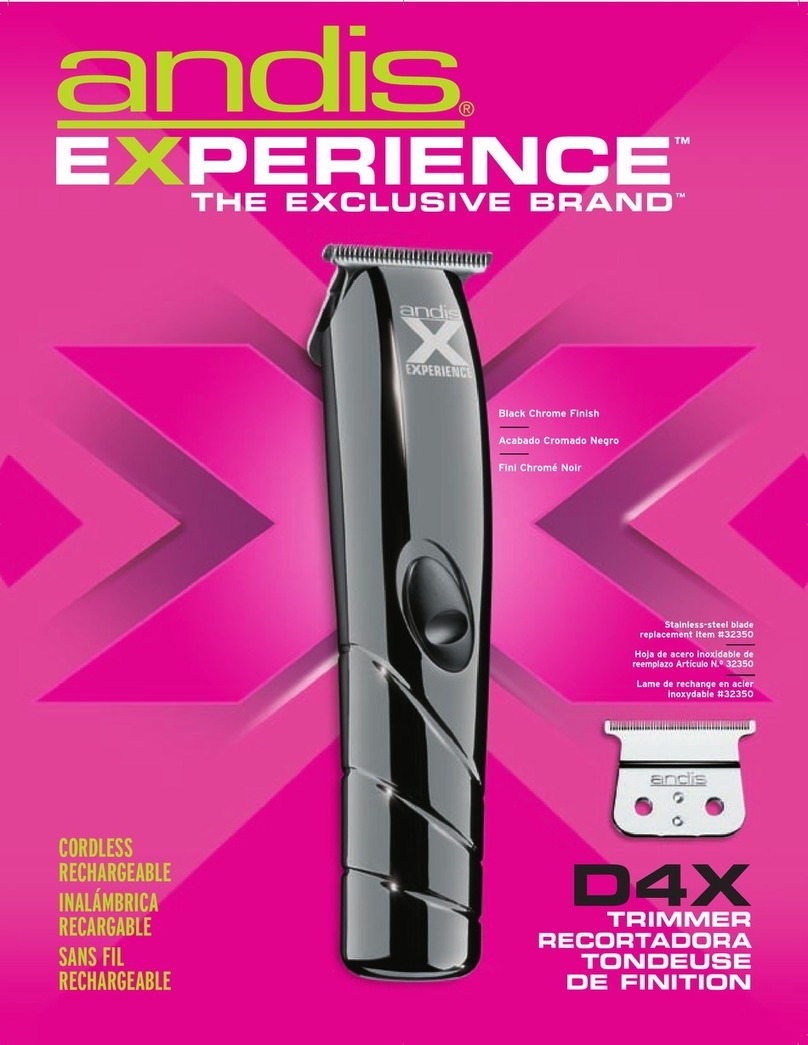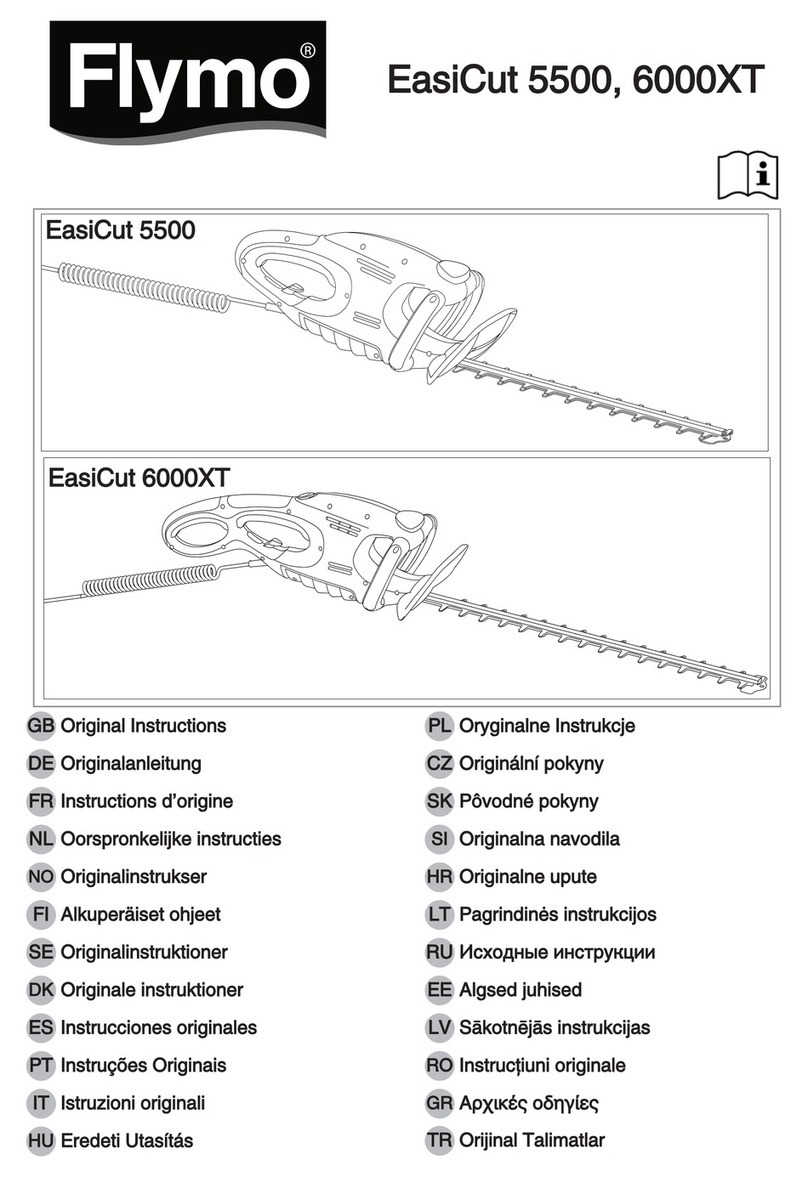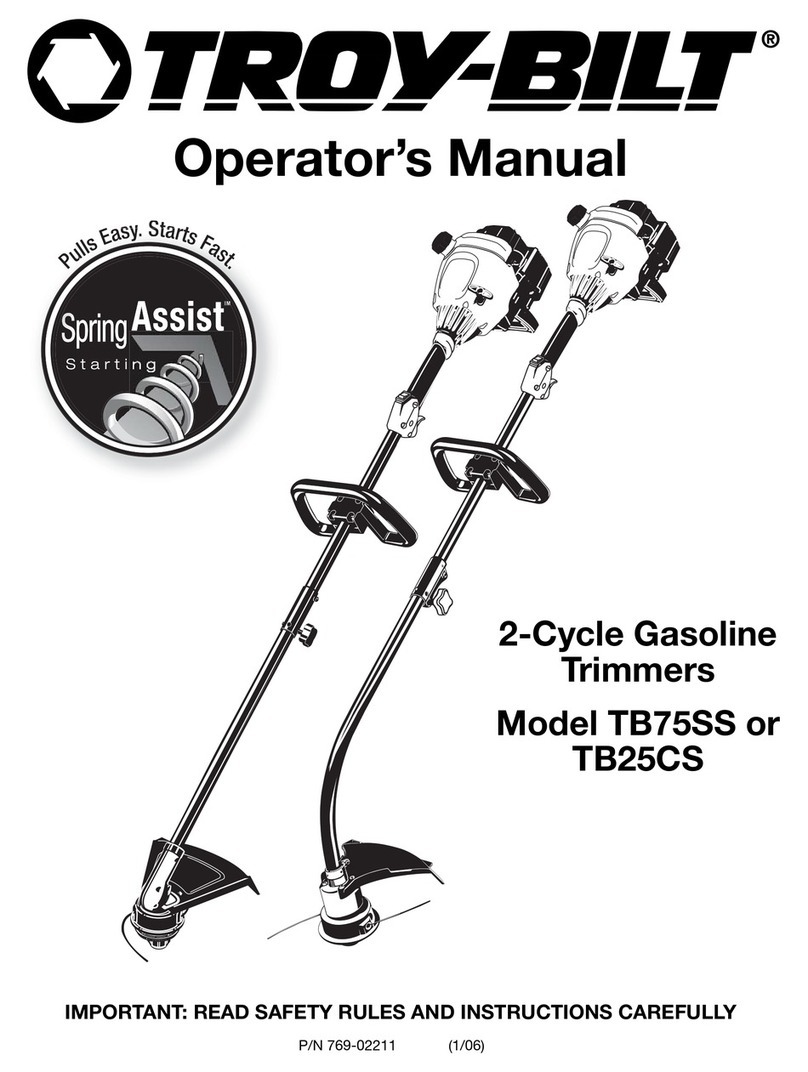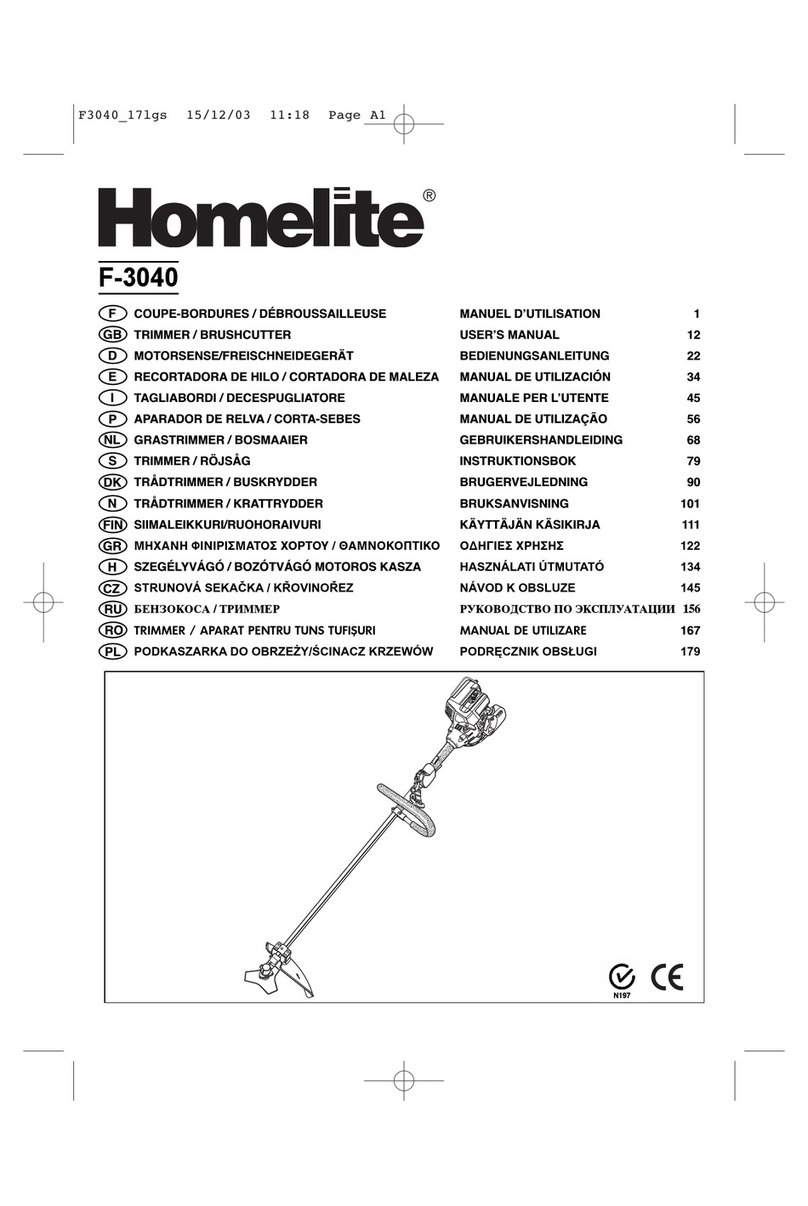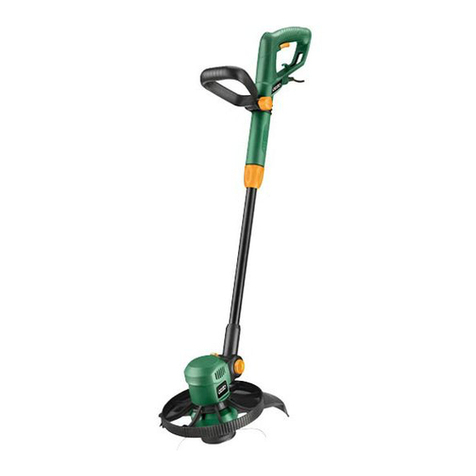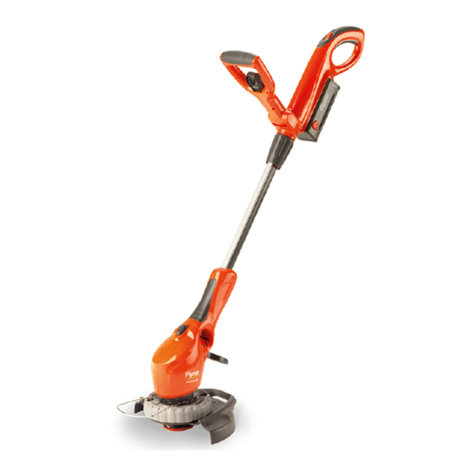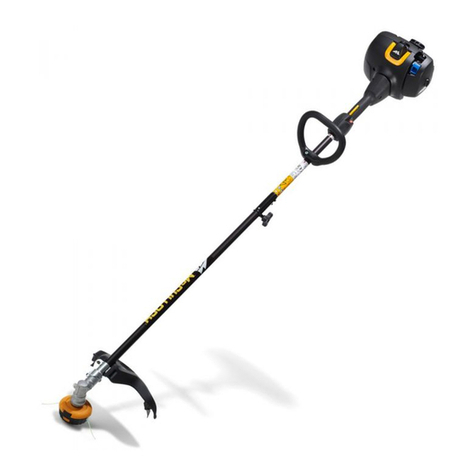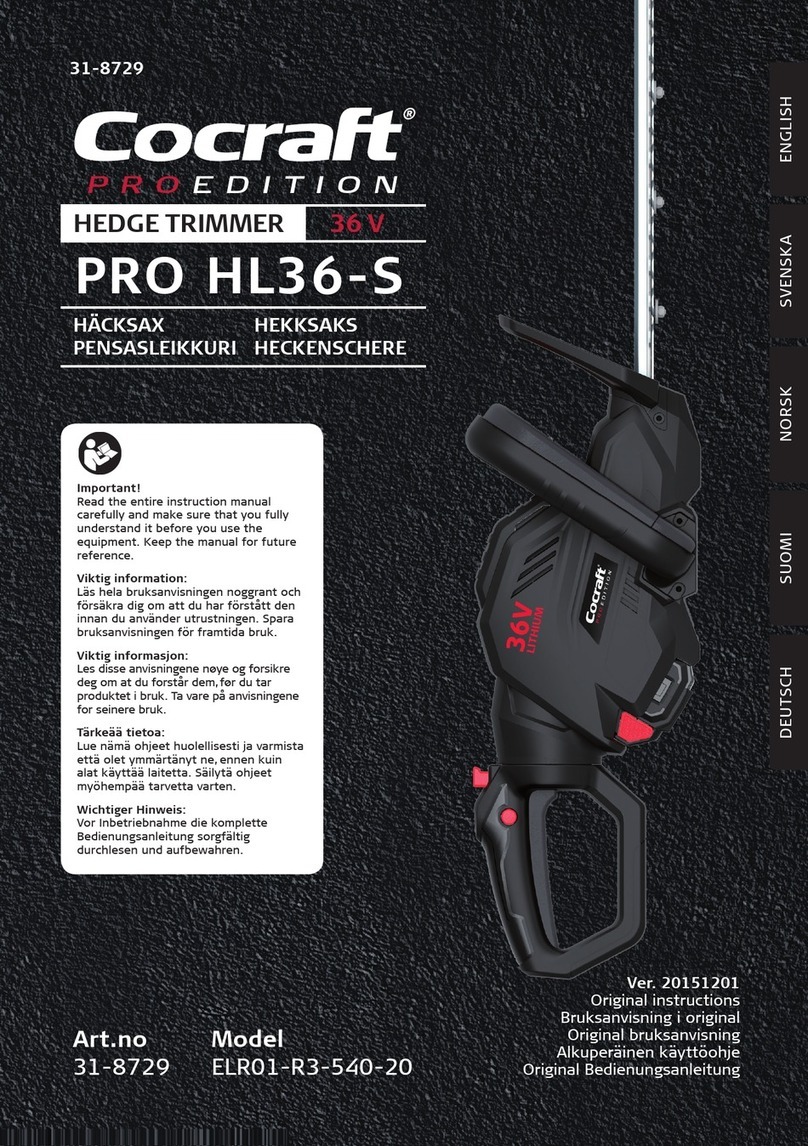Ryobi RLT3626E User manual

RBC36X26B
RBC36X26E
ORIGINAL INSTRUCTIONS
Cordless Line Trimmer
RLT3626E
RLT3600E

Important!
It is essential that you read the instructions in this manual before assembling,
operating and maintaining the product.
Subject to technical modifications.

Operation
1
Safety, performance, and dependability have been given
top priority in the design of your cordless line trimmer.
INTENDED USE
Some regions have regulations that restrict the use of the
product to some operations. Check with your local authority
for advice.
The product is designed for cutting grass and light weeds
only in private garden areas.
The product is not intended to be used in public gardens,
parks, sports centers or at roadsides. The product is not
designed for agricultural and forestry use.
The product is not intended to be used for cutting or
chopping hedges, shrubs, bushes, flowers and compost.
GENERAL SAFETY WARNINGS
WARNING
Read all safety warnings and all instructions. Failure
to follow the warnings and instructions may result in
electric shock, fire and/or serious injury.
Save all warnings and instructions for future reference.
The term “power tool” in the warnings refers to your mains-
operated (corded) power tool or battery-operated (cordless)
power tool.
WORK AREA SAFETY
■Keep work area clean and well lit. Cluttered or dark
areas invite accidents.
■Do not operate power tools in explosive
atmospheres, such as in the presence of flammable
liquids, gases or dust. Power tools create sparks
which may ignite the dust or fumes.
■Keep children and bystanders away while operating
a power tool. Distractions can cause you to lose
control.
ELECTRICAL SAFETY
■Power tool plugs must match the outlet. Never
modify the plug in any way. Do not use any adapter
plugs with earthed (grounded) power tools.
Unmodified plugs and matching outlets will reduce risk
of electric shock.
■Avoid body contact with earthed or grounded
surfaces, such as pipes, radiators, ranges and
refrigerators. There is an increased risk of electric
shock if your body is earthed or grounded.
■Do not expose power tools to rain or wet conditions.
Water entering a power tool will increase the risk of
electric shock.
■Do not abuse the cord. Never use the cord for
carrying, pulling or unplugging the power tool.
Keep cord away from heat, oil, sharp edges or
moving parts. Damaged or entangled cords increase
the risk of electric shock.
■When operating a power tool outdoors, use an
extension cord suitable for outdoor use. Use of a
cord suitable for outdoor use reduces the risk of electric
shock.
■If operating a power tool in a damp location is
unavoidable, use a residual current device (RCD)
protected supply. Use of an RCD reduces the risk of
electric shock.
PERSONAL SAFETY
■Stay alert, watch what you are doing and use
common sense when operating a power tool. Do
not use a power tool while you are tired or under the
influence of drugs, alcohol or medication. A moment
of inattention while operating power tools may result in
serious personal injury.
■Use personal protective equipment. Always wear
eye protection. Protective equipment such as dust
mask, non-skid safety shoes, hard hat, or hearing
protection used for appropriate conditions will reduce
personal injuries.
■Prevent unintentional starting. Ensure the switch
is in the off-position before connecting to power
source and/or battery pack, picking up or carrying
the tool. Carrying power tools with your finger on the
switch or energising power tools that have the switch
on invites accidents.
■Remove any adjusting key or wrench before turning
the power tool on. A wrench or a key left attached to
a rotating part of the power tool may result in personal
injury.
■Do not overreach. Keep proper footing and balance
at all times. This enables better control of the power
tool in unexpected situations.
■Dress properly. Do not wear loose clothing or
jewellery. Keep your hair, clothing and gloves away
from moving parts. Loose clothes, jewellery or long
hair can be caught in moving parts.
■If devices are provided for the connection of dust
extraction and collection facilities, ensure these are
connected and properly used. Use of dust collection
can reduce dust-related hazards.
POWER TOOL USE AND CARE
■Do not force the power tool. Use the correct power
tool for your application. The correct power tool will
do the job better and safer at the rate for which it was
designed.
■Do not use the power tool if the switch does not turn
it on and off. Any power tool that cannot be controlled
with the switch is dangerous and must be repaired.
■Disconnect the plug from the power source and/or
the battery pack from the power tool before making
any adjustments, changing accessories, or storing

Operation
2
power tools. Such preventive safety measures reduce
the risk of starting the power tool accidentally.
■Store idle power tools out of the reach of children
and do not allow persons unfamiliar with the power
tool or these instructions to operate the power tool.
Power tools are dangerous in the hands of untrained
users.
■Maintain power tools. Check for misalignment or
binding of moving parts, breakage of parts and any
other condition that may affect the power tool’s
operation. If damaged, have the power tool repaired
before use. Many accidents are caused by poorly
maintained power tools.
■Keep cutting tools sharp and clean. Properly
maintained cutting tools with sharp cutting edges are
less likely to bind and are easier to control.
■Use the power tool, accessories and tool bits etc.
in accordance with these instructions, taking into
account the working conditions and the work to
be performed. Use of the power tool for operations
different from those intended could result in a
hazardous situation.
BATTERY TOOL USE AND CARE
■Recharge only with the charger specified by the
manufacturer. A charger that is suitable for one type
of battery pack may create a risk of fire when used with
another battery pack.
■Use power tools only with specifically designated
battery packs. Use of any other battery packs may
create a risk of injury and fire.
■When battery pack is not in use, keep it away from
other metal objects, like paper clips, coins, keys,
nails, screws or other small metal objects, that can
make a connection from one terminal to another.
Shorting the battery terminals together may cause
burns or a fire.
■Under abusive conditions, liquid may be ejected
from the battery; avoid contact. If contact
accidentally occurs, flush with water. If liquid
contacts eyes, additionally seek medical help.
Liquid ejected from the battery may cause irritation or
burns.
SERVICE
■Have your power tool serviced by a qualified repair
person using only identical replacement parts.
This will ensure that the safety of the power tool is
maintained.
WARNING
Injuries may be caused, or aggravated, by prolonged
use of a tool. When using any tool for prolonged periods,
ensure you take regular breaks.
LINE TRIMMER SAFETY WARNINGS
■Never allow children or people unfamiliar with the
instructions to use the product.
■Avoid using the product in bad weather, especially
there is a risk of lightning.
■Use the product in daylight or good artificial light.
■Keep bystanders, children and pets 15 m away from the
product while in use. Stop the product if anyone enters
the area.
■Avoid using on wet grass.
■Keep proper footing and balance at all times.
■Do not walk backwards when using the product.
■Walk, never run.
■Keep the cutting head attachment below waist level.
■Never operate the product with damaged guards or
without guards in place, Ensure the correct guards are
fitted, particularly after changing cutting attachments.
■Never fit a metal replacement line.
■Keep hands and feet away from the cutting means at
all times and especially when switching on the motor.
■Beware, the cutting elements continue to rotate after
the motor is switched off.
■Beware of objects thrown by the cutting means. Clear
debris like small stones, gravel and other foreign
objects from the work area before starting operation.
Wires or string may become entangled with the cutting
means.
■Switch off and remove the battery pack before:
●servicing
●leaving the product unattended
●cleaning the product
●changing accessories
●checking for any damage after hitting an object
●checking for any damage if the product starts to
vibrate abnormally
●performing maintenance
■Wear full eye and hearing protection while operating the
product. If working in an area where there is a risk of
falling objects, head protection must be worn.
■Hearing protection may restrict the operator’s ability
to hear warning sounds, pay particular attention to
potential hazards around and inside the working area.
■Wear heavy long trousers, non-slip protective footwear,
and gloves. Do not wear loose fitting clothing, short
trousers, jewellery of any kind, or use with bare feet.
■Secure long hair so it is above shoulder level to prevent
entanglement in moving parts.
■The small blade fitted to the lawn trimmer guard is
designed to trim the new extended line to the correct
length for safe and optimum performance. The blade is
very sharp; do not touch it, particularly when cleaning
the tool.
■Always ensure that ventilation openings are kept clear

Operation
3
of debris.
■Before use and after any impact, check that there are
no damaged parts. Examine the cutting means for signs
of cracking or other damage. A defective switch or any
part that is damaged should be properly repaired or
replaced by an authorised service facility.
■Make sure the head attachment is properly installed
and securely fastened.
■Make sure all guards, deflectors and handles are
properly and securely attached.
■Do not modify the product in any way, this may increase
the risk of injury to yourself or others.
■Use only the manufacturer’s replacement cutting line.
Do not use any other cutting attachment.
MAINTENANCE
WARNING
Use only original manufacturer’s replacement parts,
accessories and attachments. Failure to do so can
cause possible injury, poor performance and may void
your warranty.
WARNING
Servicing requires extreme care and knowledge
and should be performed only by a qualified service
technician. For service, we suggest you bring the
product to your nearest authorised service centre for
repair. When servicing, use only identical replacement
parts.
■You may make adjustments and repairs described
here. For other repairs, contact the authorised service
agent.
■Always remove the battery pack from the product
before conducting any maintenance, cleaning work or
when not in use.
■Before any maintenance or adjustment, disable the
product by removing the power source.
■After extending new cutter line or cleaning, always
return the product to its normal operating position
before starting.
■After each use, clean the product with a soft dry cloth.
■Check all nuts, bolts and screws at frequent intervals
for proper tightness to ensure the product is in safe
working condition. Any part that is damaged should be
properly repaired or replaced by an authorised service
centre.
TRANSPORTATION AND STORAGE
■Stop the product and allow it to cool before storing
or transporting. Do not store or transport the product
with batteries fitted. Remove and separately store the
batteries.
■Clean all foreign material from the product. Store the
product in a cool dry and well-ventilated place that is
inaccessible to children. Keep away from corrosive
agents, such as garden chemicals and de-icing salts.
Do not store outdoors.
■For transportation, secure the product against
movement or falling to prevent injury to persons or
damage to the product.
TRANSPORTING LITHIUM BATTERIES
Transport the battery in accordance with local and national
provisions and regulations.
Follow all special requirements on packaging and labelling
when transporting batteries by a third party. Ensure that
no batteries can come in contact with other batteries
or conductive materials while in transport by protecting
exposed connectors with insulating, non-conductive caps
or tape. Do not transport batteries that are cracked or
leaking. Check with the forwarding company for further
advice.
BATTERY PROTECTION
Ryobi 36 V lithium-ion batteries are designed with features
that protect the lithium-ion cells and maximise battery life.
If the product stops during use, the following may be the
causes:
■The maximum current draw of the battery has been
exceeded, causing it to automatically stop powering the
product. Release the trigger to reset the product and
pull the trigger to resume operation.
■Excessive temperatures will cause the battery to stop
powering the product. Feel the battery pack; if it is too
warm, allow it to cool down.
RESIDUAL RISKS
Even when the product is used as prescribed, it is still
impossible to completely eliminate certain residual risk
factors. The following hazards may arise in use and the
operator should pay special attention to avoid the following:
■Injury caused by vibration. Hold the tool by designated
handles and restrict working time and exposure.
■Exposure to noise can cause hearing injury. Wear ear
protection and limit exposure.
■Eye injury due to flying debris. Wear eye protection at
all times.
RISK REDUCTION
It has been reported that vibrations from hand-held tools
may contribute to a condition called Raynaud’s Syndrome
in certain individuals. Symptoms may include tingling,
numbness and blanching of the fingers, usually apparent
upon exposure to cold. Hereditary factors, exposure to
cold and dampness, diet, smoking and work practices
This manual suits for next models
1
Table of contents
Other Ryobi Trimmer manuals

Ryobi
Ryobi RHT1851R25F User manual
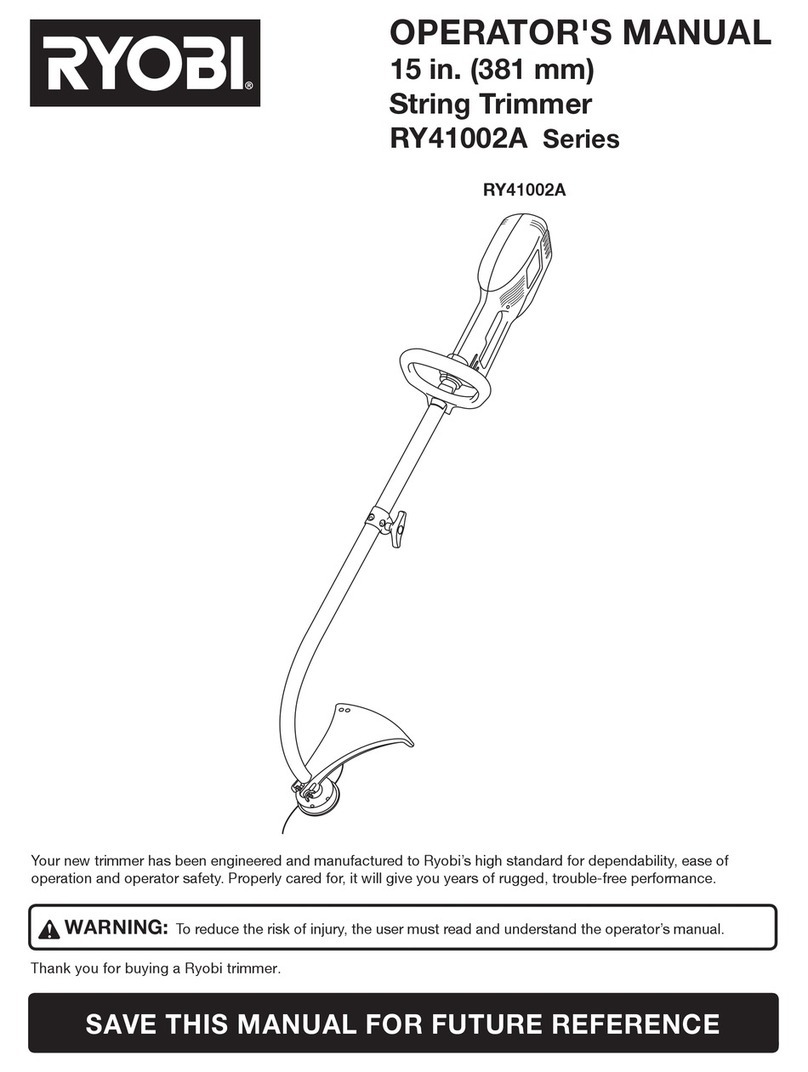
Ryobi
Ryobi RY41002A Series User manual
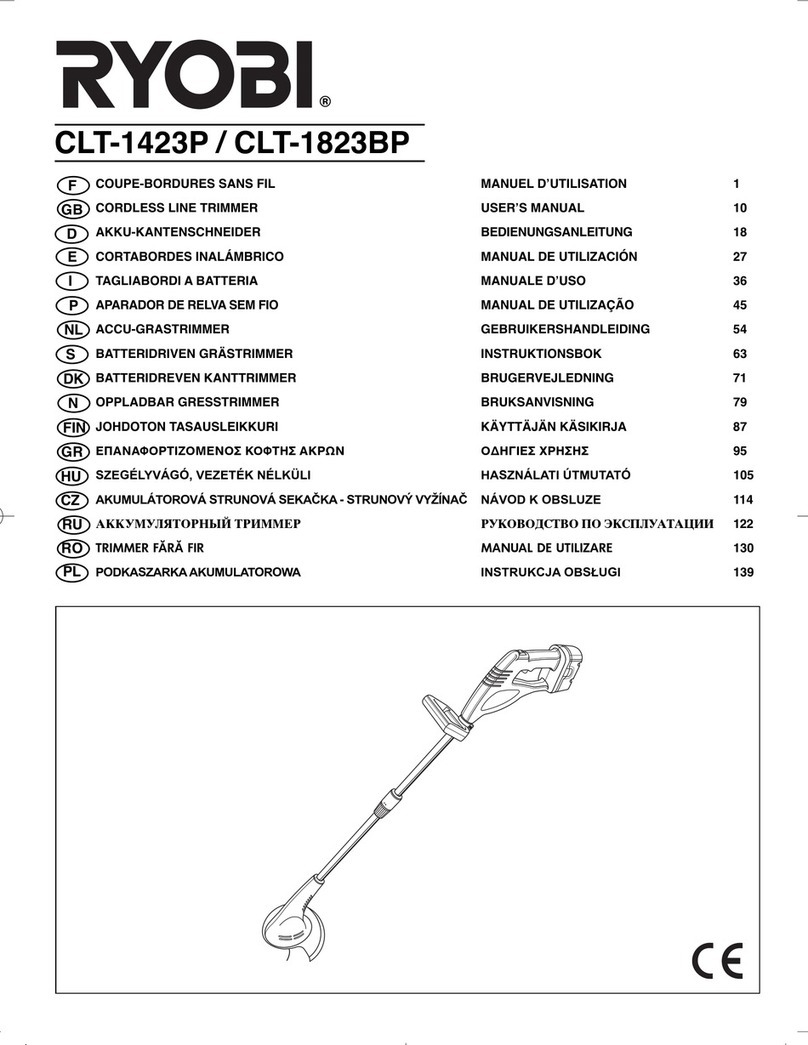
Ryobi
Ryobi CLT-1423P User manual

Ryobi
Ryobi Expand-It RY15704 User manual
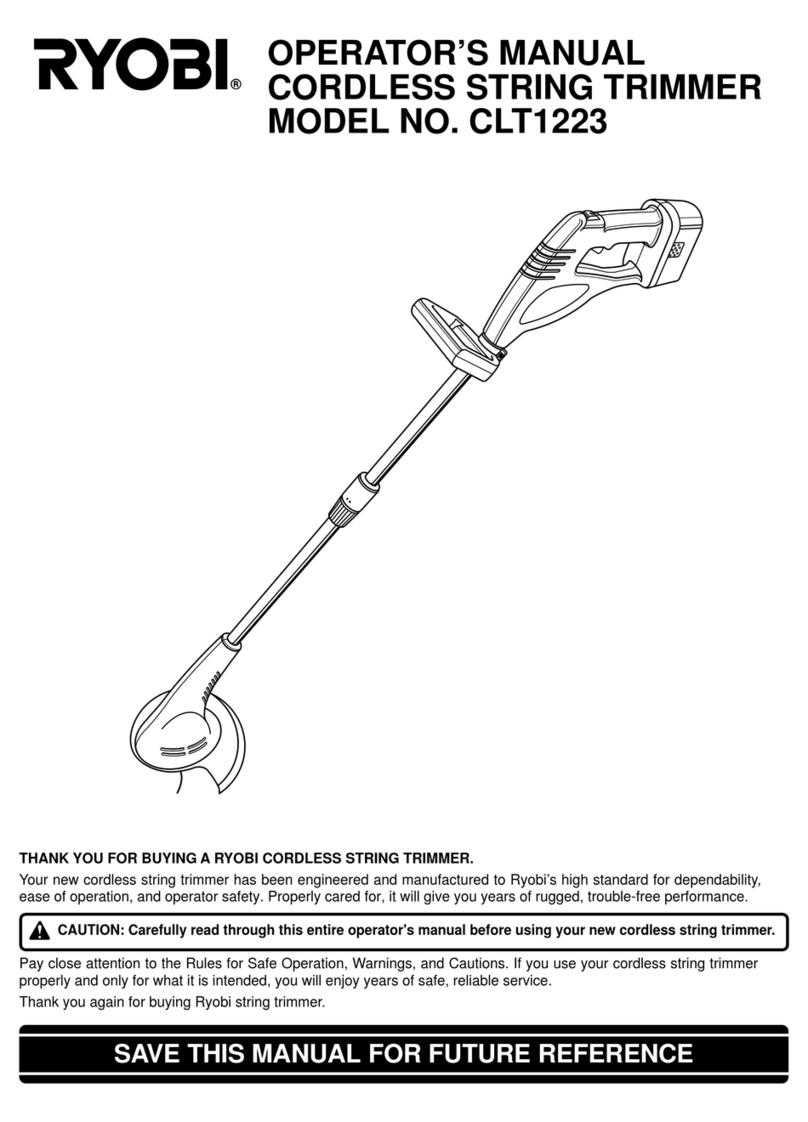
Ryobi
Ryobi CLT1223 User manual

Ryobi
Ryobi RLT1238 User manual

Ryobi
Ryobi RY28100 Quick setup guide
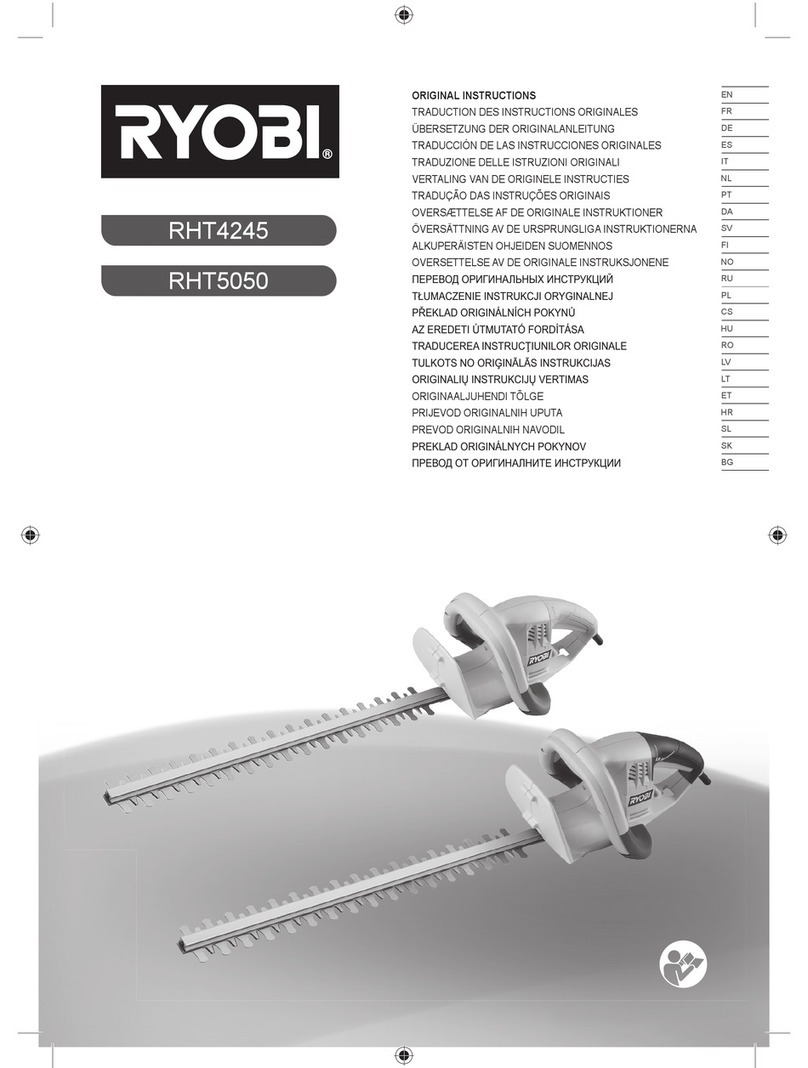
Ryobi
Ryobi RHT4245 User manual
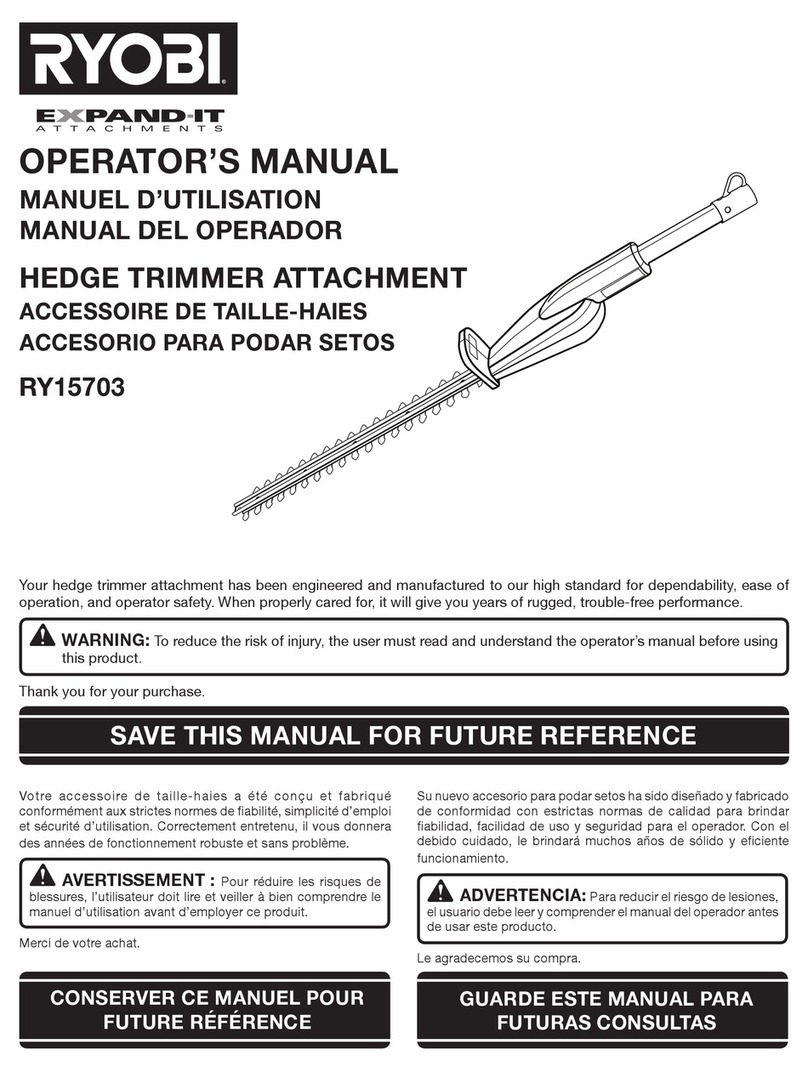
Ryobi
Ryobi Expand-It RY15703 User manual
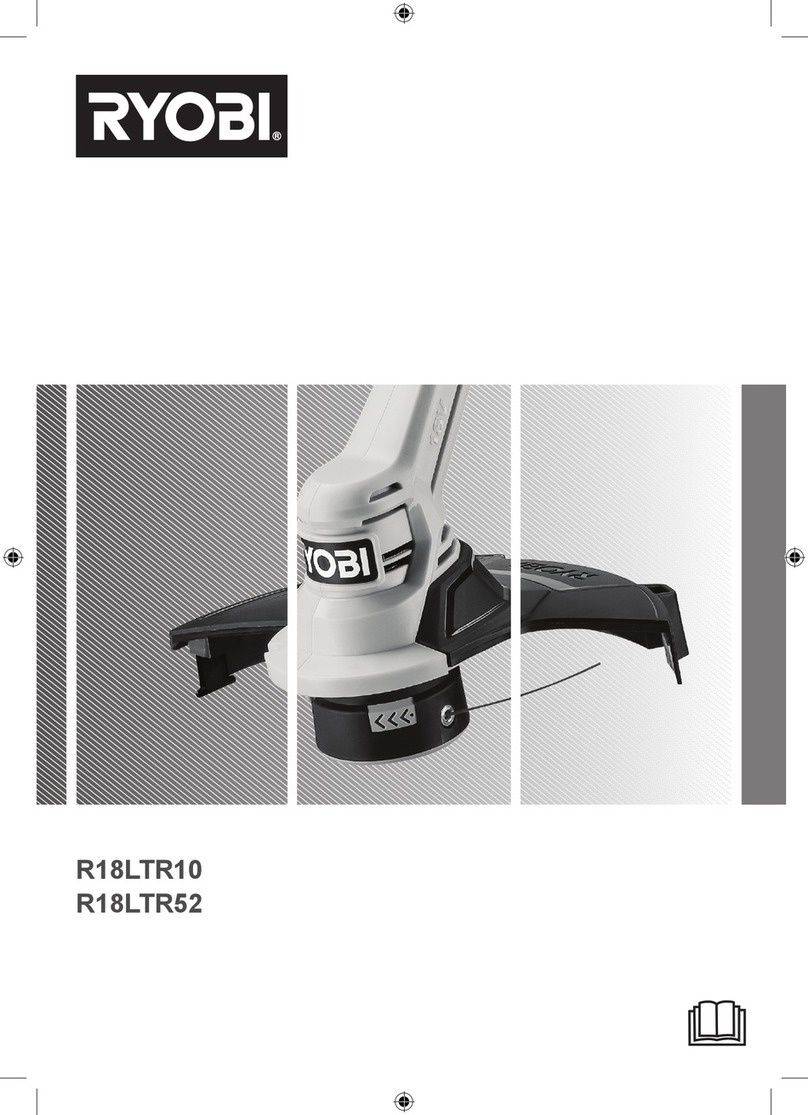
Ryobi
Ryobi R18LTR10 User manual

Ryobi
Ryobi R36HTRBL User manual

Ryobi
Ryobi OPT1845 User manual
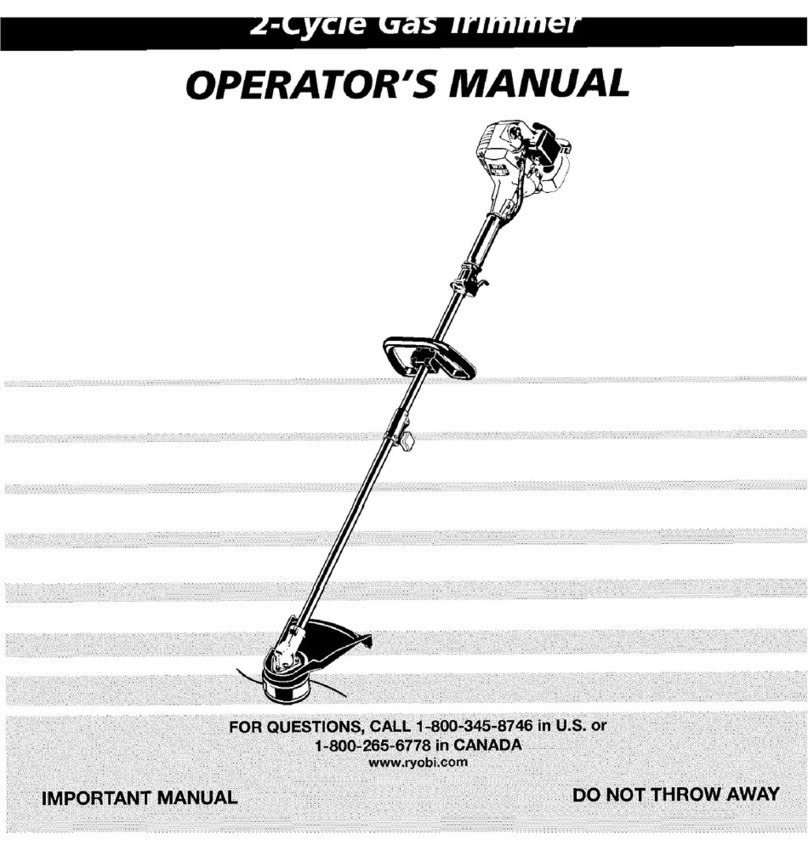
Ryobi
Ryobi Trimmer User manual

Ryobi
Ryobi One+ OHT1800P User manual
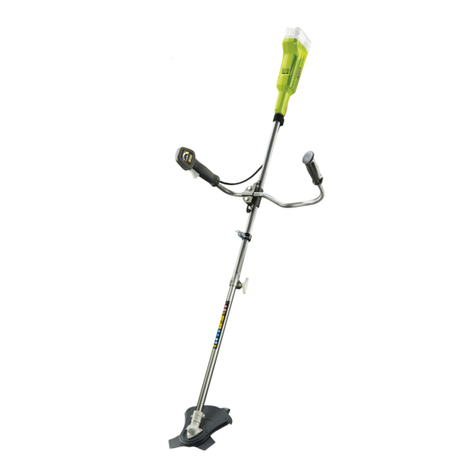
Ryobi
Ryobi RBC18X20B4 User manual

Ryobi
Ryobi 890r User manual
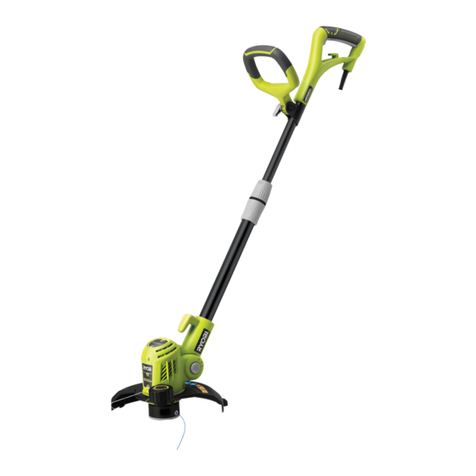
Ryobi
Ryobi RLT5030S User manual

Ryobi
Ryobi RY18LT23 User manual
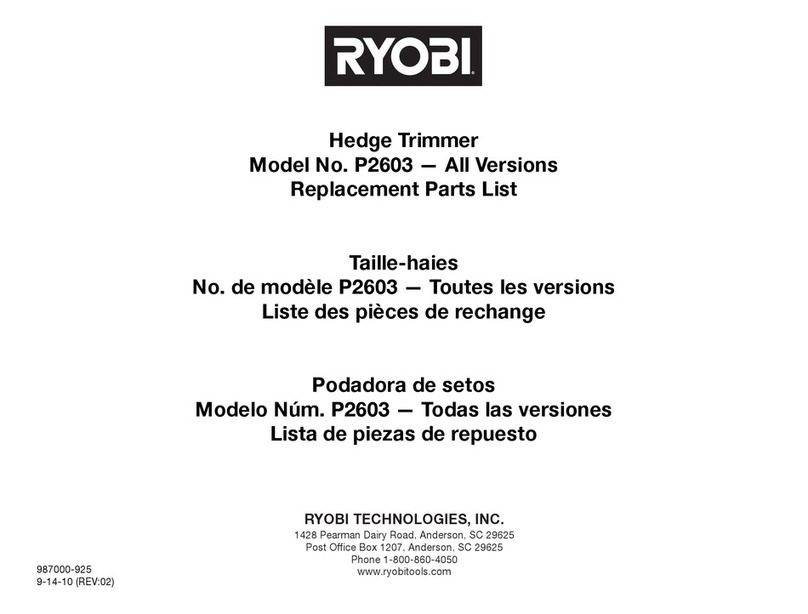
Ryobi
Ryobi P2603 Application guide
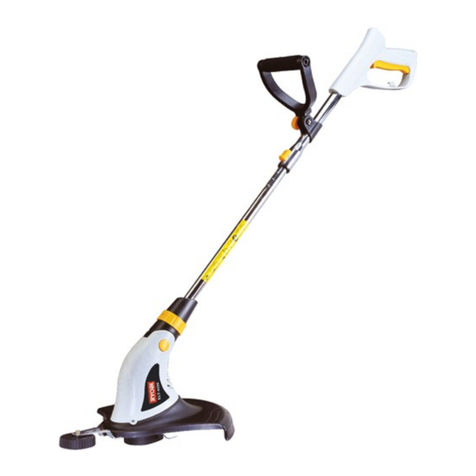
Ryobi
Ryobi ELT-3725 User manual

